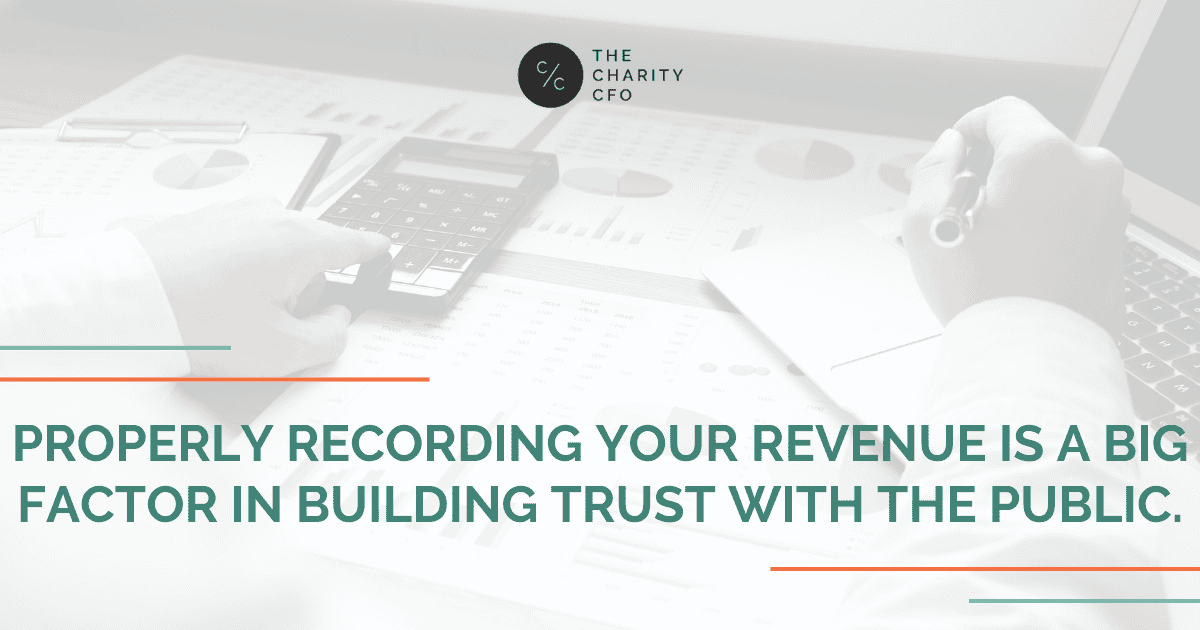How to Properly Record Revenue for Nonprofits
While the nature of a nonprofit means you’re focusing more on your mission than making money, bringing in revenue is still essential.
This can lead to unique accounting and recordkeeping challenges that for-profit businesses don’t have to face—especially related to revenue classification. Accurate revenue recognition, classification, and records are some of the most important aspects of nonprofit accounting.
Not only does it help with transparency in your organization, but properly recording revenue keeps you in compliance with nonprofit regulations.
Let’s take a look at common revenue streams and how to record revenue for a nonprofit.

Nonprofit Revenue Streams
To be able to properly record nonprofit revenue, you first have to understand what types of revenue streams a nonprofit might have. Many nonprofit organizations receive a variety of funding from many different sources—from membership fees to annual fundraisers. This revenue helps run your programs, pay staff, build operating reserves, and cover administrative costs.
The most common types of revenue for nonprofits include:
- Donations and Contributions: These are monetary contributions made to your organization, often from individuals.
- Grants and Sponsorships: Grants are typically monetary donations that come from other organizations and often have restrictions on their use, such as a government grant. Sponsorships are donations from an organization or business in exchange for promotion, such as displaying a banner at a fundraising event.
- Program Service Fees: Many nonprofits charge fees for the services they provide, such as a ticket fee for a nonprofit theater.
- In-Kind Contributions: In-kind contributions are non-monetary donations to your organization and might include food donations to a food bank.
There are further breakdowns within your revenue streams, most notably restricted versus unrestricted funds.
Restricted funds are donations that must be used in a specific way or for a certain purpose. Unrestricted funds are just the opposite—this money can be used for any purpose the nonprofit sees fit.
Accrual vs. Cash Basis Accounting for Nonprofits
There are two main types of accounting for nonprofits: the accrual method and the cash basis method.
- Accrual Method: The accrual method records revenues as they are earned or pledged. Likewise, expenses are recorded when they are incurred.
- Cash Basis: The cash method of accounting records revenue when it’s received and expenses when they are paid.
In essence, the accrual method focuses on recording revenues and expenses when you learn of them. The cash basis method, on the other hand, focuses on recording revenues and expenses when money changes hands.
Which method is best?
That depends on your organization’s size and complexity. Generally, most small nonprofits can use the cash basis method as it may be simpler. A larger nonprofit (or one with a lot of complicated transactions) may need to use the accrual method.
Recording Revenue for Nonprofits
Donations and Contributions
When recording donations for your nonprofit, technology is your best friend. There are plenty of software and tech options that make it easy to properly record nonprofit donations.
Why use technology to track donations? Because donations are generally an organization’s most common revenue transactions and may have restricted and unrestricted funds coming in equally.
You can also use a donor acknowledgment system to help track donations and make donors feel appreciated.
For example, you might set up a donation portal on your website. When someone donates, they receive an email thanking them for their contribution immediately.
As donations can come from many sources, it’s very important to separate restricted and unrestricted funds when recording to help you keep up with donation rules.
Grant and Sponsorship Revenue
While grants and sponsorships have similarities, you must keep each type of fund separate. Like restricted and unrestricted funds, keeping grant and sponsorship money can save you headaches at tax time (and when communicating with donors).
Sponsorships are often one-time donations in the form of advertisements or promotions for the sponsoring business. For example, a local restaurant sponsors your annual fundraising gala. In return, you display posters around the event thanking the restaurant.
Grants, on the other hand, usually involve a much lengthier application and approval process. You’ll need to make sure you record grant revenue based on the conditions outlined in the grant agreement.
In addition, grant-funded programs often have their own set of rules and requirements for recording. Proper record-keeping for grant revenue is important to stay in compliance with rules for grant funding.
For a deeper dive into revenue accounting for grants, check out this article by the FASB which clarifies how grants fit into the new standard.
Program Service Fees and Earned Income
Just because a nonprofit isn’t aiming to turn a profit doesn’t mean they can’t charge for their services. Many nonprofits charge service fees or program fees to help cover the cost of running the organization.
For instance, an animal shelter charges an adoption fee to adopt a pet. These adoption fees help pay for animal care, veterinary services, and shelter employee wages.
Any program service fees and other earned income your organization brings in should be recorded separately from donations and contributions. Differentiating between program service fees and constrictions helps maintain clean records and can lower your risk of compliance issues if your nonprofit is audited.
Recognizing In-Kind Contributions
In-kind donations can pose a range of accounting challenges for nonprofits. The most important aspect of recording in-kind donations is proper valuation.
Establishing an in-kind donation valuation and recording process will help you avoid mistakes when receiving non-monetary donations.
A strong in-kind donation recording system will help you stay in compliance with accounting standards for in-kind contributions.
Need Help Recording Revenue? Reach Out to the Charity CFO!
Understanding your nonprofit’s revenue stream and knowing how to record it is essential to staying in compliance with nonprofit rules and regulations. Properly recording your revenue is also a big factor in building trust with the public, as it shows transparency.
Feeling a little overwhelmed about your revenue streams and other accounting processes? The Charity CFO provides expert tax and accounting services for nonprofits. Our team has decades of collective experience working with nonprofits. We put our knowledge to work to help address and resolve the unique accounting challenges nonprofits face.
Let us help your nonprofit get financially organized through proper revenue recordkeeping. Contact us today for a free consultation.







